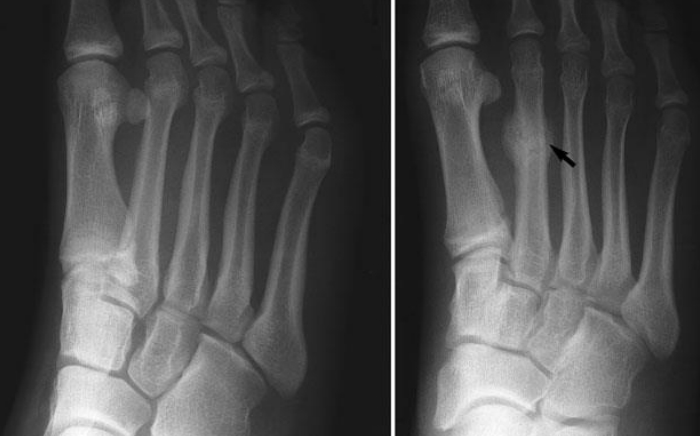When excessive stress is placed upon the ball of the foot, a hairline break (fracture) of a long metatarsal bone may occur. This occurs most frequently to the second, third, or fourth metatarsal but can occur in any bone. Frequently, the injury is so subtle that you may not recall any specific occurrence. These fractures were at one time referred to as “March Fractures” in soldiers, who developed foot pain after long periods of marching. Stress fractures can occur during sports activities, in overweight individuals, or in those with weakened bones such as osteoporosis.
Diagnosis
A typical presentation for someone with a metatarsal stress fracture would be pain and swelling in the ball of the foot, which is most severe in the push off phase of walking. Pressing on the bones in this area of the foot will reproduce the pain. X-rays taken during the first two to three weeks after the injury often will not show any fracture. A bone scan at this stage will be much more sensitive in diagnosing the early stress fracture. The decision to order a bone scan will be up to your doctor. Often times the diagnosis can be made based upon clinical findings, thus making the bone scan unnecessary. After several weeks, an x-ray will show the signs of new bone healing in the area of the stress fracture.
Treatment
Treatment for a metatarsal stress fracture usually consists of rest, elevation, and ice initially. Sometimes a compression bandage is applied to help reduce the swelling. Frequently a post-operative type of shoe or removable below the knee cast is used to prevent you from pushing off the ball of your foot, thus eliminating any additional stress while the bone is healing. Occasionally a short leg walking cast may be applied for a short period of time. Typical healing times range from 4 to 8 weeks. After the fracture is healed, special attention should be paid to using a well-padded insole or a functional orthotic in the shoes to reduce the stress in this area. For those who may have osteoporosis, bone densitometry testing should be done, and appropriate treatment initiated to prevent further weakening of the bones.

